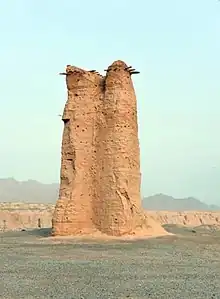 | |
 Shown within Xinjiang | |
| Location | Xinjiang, China |
|---|---|
| Coordinates | 41°47′30″N 82°53′55″E / 41.791667°N 82.898611°E |
The Kizilgaha Caves (simplified Chinese: 克孜尔尕哈石窟; traditional Chinese: 克孜爾尕哈石窟; pinyin: Kèzīěrgǎhā shíkū) consist in a Buddhist Temple inside a complex of caves in the area of Kucha, Xinjiang, China. The paintings in the cave go back to the 5th century CE.[1] Other famous sites nearby are the Ah-ai Grotto, Kizil Caves, Kumtura, Subashi Temple and the Simsim caves.[2]
Gallery
 Kizilgaha beacon tower
Kizilgaha beacon tower Donors in Tocharian clothing, Kizilgaha cave 14, Kucha
Donors in Tocharian clothing, Kizilgaha cave 14, Kucha Donors in Tocharian clothing, Kizilgaha, cave 30.
Donors in Tocharian clothing, Kizilgaha, cave 30.
References
Wikimedia Commons has media related to Kizilgaha.
- ↑ Yamauchi, Kazuya; Taniguchi, Yoko; Uno, Tomoko; Conservation, Japan Center for International Cooperation in (2007). Mural Paintings of the Silk Road: Cultural Exchanges Between East and West : Proceedings of the 29th Annual International Symposium on the Conservation and Restoration of Cultural Property, National Research Institute for Cultural Properties, Tokyo, January 2006. Archetype. p. 35. ISBN 978-1-904982-22-7.
- ↑ (Other than Kizil)... "The nearby site of Kumtura contains over a hundred caves, forty of which contain painted murals or inscriptions. Other cave sites near Kucha include Subashi, Kizilgaha, and Simsim." in Buswell, Robert E.; Lopez, Donald S. (24 November 2013). The Princeton Dictionary of Buddhism. Princeton University Press. p. 438. ISBN 978-1-4008-4805-8.
This article is issued from Wikipedia. The text is licensed under Creative Commons - Attribution - Sharealike. Additional terms may apply for the media files.